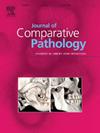Forensic wound age estimation in dog tissue correlated with newly formed collagen fibres: a retrospective study
IF 0.8
4区 农林科学
Q4 PATHOLOGY
引用次数: 0
Abstract
Parameters for wound age estimation are essential in forensic pathology but difficult to assess. With this retrospective study, wound age parameters in canine skin wounds were assessed with archive material of known age. Haematoxylin and eosin (HE) staining as standard, Prussian blue, Van Gieson (VG) and multiple other special stains were used as well as various immunohistochemistry (IHC) tests. Collagen fibre formation examination included HE staining but also immunolabelling for elastin and collagen I. Collagen fibre formation was further assessed by polarization in HE and VG. HE staining, erythrophagocytosis and presence of haemoglobin decay products in the Prussian blue stained-slides proved to be useful tools in wound age estimation in the early phase of wound repair of less than 5 days. The earliest detection of newly formed collagen was possible in 5-day-old wounds with HE and VG staining. Collagen I reactivity by IHC was weak at this time point, moderate to strong in the lesions older than 10 days and up to 30 days and strong in the lesions older than 3 months. Very slight polarization of collagen fibres was observed at 6 days, becoming stronger in wound lesions of 10–14 days and up to 30 days and reaching the same intensity as normal tissue in a 3-month-old lesion. The morphology of newly formed collagen fibres, utilizing HE and VG staining and polarization as well as collagen I IHC, which proved to be the most important parameters, correlated with distinguishable time points in the available cases of known wound age.
与新形成的胶原纤维相关的狗组织法医伤口年龄估计:一项回顾性研究
伤口年龄估计参数在法医病理学中至关重要,但却很难评估。这项回顾性研究利用已知年龄的档案材料对犬皮肤伤口的年龄参数进行了评估。使用了标准的血色素和伊红(HE)染色法、普鲁士蓝、范吉森(VG)和其他多种特殊染色法以及各种免疫组化(IHC)测试。胶原纤维形成检查包括 HE 染色以及弹性蛋白和胶原 I 的免疫标记。HE 染色、红细胞吞噬以及普鲁士蓝染色切片中血红蛋白衰变产物的存在,被证明是在伤口修复不到 5 天的早期阶段估计伤口年龄的有用工具。用 HE 和 VG 染色法可在 5 天大的伤口中最早检测到新形成的胶原蛋白。在这个时间点,IHC 检测到的胶原 I 反应性较弱,10 天以上和 30 天以内的病变反应性中等到较强,3 个月以上的病变反应性较强。在 6 天时观察到胶原纤维极化非常轻微,在 10-14 天和 30 天的伤口病变中变得更强,在 3 个月的病变中达到与正常组织相同的强度。在已知伤口年龄的病例中,新形成的胶原纤维的形态、HE 和 VG 染色、极化以及胶原 I IHC(这是最重要的参数)与可区分的时间点相关。
本文章由计算机程序翻译,如有差异,请以英文原文为准。
求助全文
约1分钟内获得全文
求助全文
来源期刊
CiteScore
1.60
自引率
0.00%
发文量
208
审稿时长
50 days
期刊介绍:
The Journal of Comparative Pathology is an International, English language, peer-reviewed journal which publishes full length articles, short papers and review articles of high scientific quality on all aspects of the pathology of the diseases of domesticated and other vertebrate animals.
Articles on human diseases are also included if they present features of special interest when viewed against the general background of vertebrate pathology.

 求助内容:
求助内容: 应助结果提醒方式:
应助结果提醒方式:


